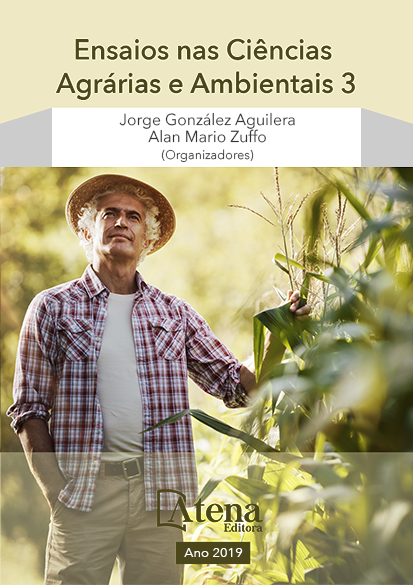
Aplicação de extrato pirolenhoso e hidrogel no desenvolvimento de plantas de alface
Como alternativas ao uso
convencional da irrigação e adubação na
cultura da alface, a utilização de hidrogel e
extrato pirolenhoso (EP) pode ser eficiente
no desempenho agronômico da referida
cultura. Nesse sentido, objetivou-se com este
trabalho avaliar a influência do EP associado
ao hidrogel no desenvolvimento de plantas
de alface sob as condições de Boa Vista,
RR. O experimento foi conduzido em vasos
de polietileno com capacidade de 3,6 L. Os
tratamentos consistiram da utilização de EP
na presença (PH) e ausência de hidrogel (AH),
além do tratamento controle: T1- Testemunha
(AH e 0 mL de EP); T2- PH e 0 mL de EP; T3-
PH e 25 mL de EP; T4- PH e 50 mL de EP; T5-
PH e 100 mL de EP; T6- PH e 150 mL de EP;
T7- AH e 25 mL de EP; T8- AH e 50 mL de EP;
T9- AH e 100 mL de EP; T10- AH e 150 mL de
EP. Avaliaram-se a altura da planta, número de
folhas (NF), diâmetro do caule (DC) e clorofilas
A e B. Houve efeito significativo para o NF e DC.
Com médias inferiores a 6 folhas por planta e 5
mm de DC, os tratamentos que continham as
maiores quantidades de EP apresentaram os
menores valores para tais variáveis, indicando
que o uso de hidrogel, associado ou não com o
extrato pirolenhoso em baixas concentrações,
favoreceu o desempenho agronômico da alface
sob as condições do estudo, sendo, portanto,
uma alternativa à irrigação convencional diária.
Aplicação de extrato pirolenhoso e hidrogel no desenvolvimento de plantas de alface
-
DOI: 10.22533/at.ed.39119160120
-
Palavras-chave: Lactuca sativa L., Polímeros hidroabsorventes, subproduto da carbonização.
-
Keywords: Lactuca sativa L., Hydroabsorbent polymers, by-product of carbonization
-
Abstract:
As alternatives to the conventional use of irrigation and fertilization in
lettuce cultivation, the use of hydrogel and pirolenous extract (PE) can be efficient in
the agronomic performance of this crop. In this sense, the objective of this work was
to evaluate the influence of the hydrogel-associated PE on the development of lettuce
plants under Boa Vista, RR. The treatments consisted of the use of PE in the presence
(PH) and absence of hydrogel (AH), in addition to the control treatment: T1- Witness
(AH and 0 mL of PE); T2-PH and 0 mL of PE; T3-PH and 25 mL of PE; T4-PH and 50
mL of EP; T5-PH and 100 ml of PE; T6-PH and 150 mL of PE; T7-AH and 25 mL of
EP; T8-AH and 50 mL of EP; T9-AH and 100 mL of PE; T10-AH and 150 mL of PE.
Plant height, number of leaves (NF), stem diameter (DC) and chlorophyll A and B were
evaluated. There was a significant effect for NF and DC. With averages of less than
6 leaves per plant and 5 mm of DC, treatments containing the highest amounts of PE
presented the lowest values for such variables, indicating that the use of hydrogel,
associated or not with the pyrolignose extract in low concentrations, favored the
agronomic performance of lettuce under the conditions of the study, being, therefore,
an alternative to conventional daily irrigation.
-
Número de páginas: 15
- Kelen Mendes Almeida


